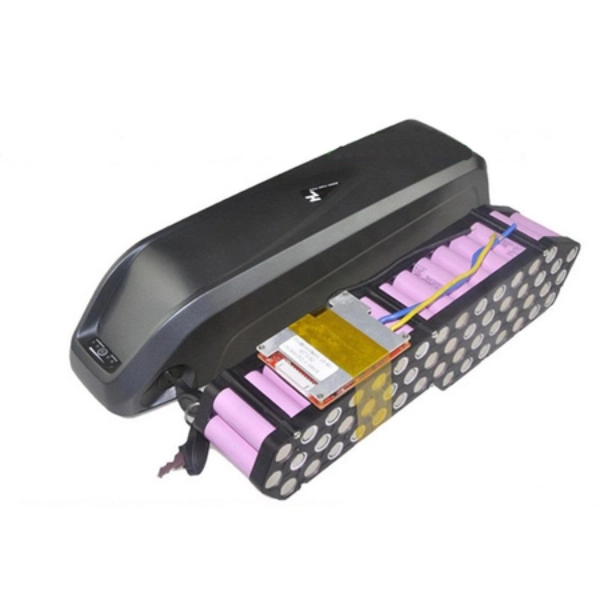One of the crucial components of an electric bike is its e-bike battery, as it determines the range, power, and overall performance. Choosing the correct battery for your bike is essential to ensure optimal performance and a satisfying riding experience.
This article will explore the various aspects of e-bike battery technology, factors to consider when selecting a battery, battery management systems, battery lifespan, and maintenance tips.

Part 1. Types of e-bike batteries
Lithium-ion Batteries
Many experts widely regard lithium-ion batteries as the most popular choice for electric bikes because of their high energy density, lightweight design, and long lifespan. These batteries offer a higher range per charge than other options. They are available in various chemistries, such as lithium iron phosphate (LiFePO4) and lithium polymer (LiPo).
Lead-Acid Batteries
Electric bike manufacturers have used lead-acid batteries for a long time. They are relatively inexpensive compared to lithium-ion batteries but are heavier and bulkier. Lead-acid batteries have lower energy density and shorter lifespan. However, they can still provide sufficient power for shorter commutes or entry-level electric bikes.
Nickel-Metal Hydride Batteries (NiMH)
Before the rise of lithium-ion batteries, electric bike manufacturers commonly used NiMH batteries. They offer moderate energy density, decent lifespan, and are more environmentally friendly than lead-acid batteries. However, their usage gradually decreases as lithium-ion batteries dominate the market.
Part 2. Factors to consider when choosing e-bike batteries
Consider several factors when selecting batteries for your electric bike to ensure optimal performance and compatibility.
- Range: How far the e-bike can travel on one charge.
- Voltage and Compatibility: Match the battery’s voltage to the e-bike’s requirements.
- Capacity and Amp-Hour Rating: Higher capacity means more power and range.
- Weight and Size: Battery weight affects bike balance and maneuverability.
- Charging Time: Consider how long it takes to charge the battery fully.
- Brand Reputation and Warranty: Choose reputable brands with good reviews and warranties.
Part 3. Battery management systems for e-bike batteries (BMS)
Battery Management Systems (BMS) play a crucial role in maintaining the performance, safety, and lifespan of e-bike batteries. BMS is an electronic system that monitors and controls the charging and discharging of the battery, preventing overcharging, over-discharging, and balancing the individual cells within the battery pack.
Part 4. How long does an e-bike battery last?
Several factors influence the lifespan of an e-bike battery.
- Battery Chemistry: Lithium-ion batteries, the most common type in e-bikes, typically last 2-7 years.
- Depth of Discharge (DoD): Shallow discharges, where you do not fully deplete the battery, are less stressful for the battery and can prolong its life.
- Charging Cycles: A charging cycle refers to discharging the battery from 100% to a certain level and then recharging it back to 100%.
- Operating Temperature: High temperatures can accelerate chemical reactions within the battery, leading to faster degradation. Similarly, frigid temperatures can temporarily reduce the battery’s capacity.
Example: Calculating Ebike Battery Life
Let’s consider an e-bike battery with a capacity of 500 watt-hours (Wh) and a manufacturer’s claim of 500 charging cycles before a significant capacity loss occurs. To estimate its lifespan, we need to consider the average distance you ride per charge and the depth of discharge.
Suppose you typically ride your e-bike for 20 miles (32 kilometers) per charge, and you usually discharge the battery to 20% of the remaining capacity before recharging. This means you use approximately 80% of the battery’s capacity per charge.
To calculate the total number of miles the battery can last, we divide the manufacturer’s specified number of charging cycles (500) by the number of cycles used per full discharge (80% of battery capacity used per charge):
500 cycles ÷ (100% – 80%) = 500 cycles ÷ 20% = 2,500 cycles
Next, we multiply the total number of cycles by the distance covered per charge:
2,500 cycles × 20 miles = 50,000 miles
Based on these calculations, the e-bike battery is estimated to last approximately 50,000 miles (80,467 kilometers) before experiencing significant capacity loss.
Understanding these factors and performing similar calculations specific to your e-bike’s battery can better appreciate its expected lifespan and help you plan for battery replacements.
Part 5. How to reset the e-bike battery?
Resetting an e-bike battery is often necessary when encountering performance issues or recalibrating the battery management system. However, it’s important to note that not all bike users can reset batteries manually. Some batteries have built-in protection circuits that automatically handle the resetting process.
If your e-bike battery requires a manual reset, follow these general steps:
- Power Off: Turn off your electric bike and disconnect the battery from the bike.
- Disconnect All Accessories: Remove any accessories or devices connected to the battery, such as lights or displays.
- Wait: Leave the battery disconnected for approximately 10-15 minutes to ensure it dissipates all residual energy.
- Reconnect: Reconnect the battery to the bike, ensuring a secure and proper connection.
- Power On: Turn on your electric bike and check if you have resolved the performance issues.
Part 6. How to store e-bike batteries for winter?
- Charge the Battery: Ensure you fully charge the battery before storing it. A full charge helps prevent self-discharge and keeps the battery healthy.
- Clean and Inspect: Clean the battery’s exterior and inspect it for any signs of damage. Address any issues before storage.
- Choose a Suitable Location: Store the battery in a cool, dry place, away from direct sunlight and extreme temperatures. Avoid storing it in freezing temperatures or scorching environments.
- Maintain a Partial Charge: Aim to maintain the battery at around 50% charge during storage. This level helps prevent over-discharge and keeps the battery in an optimal state.
- Periodic Maintenance: Check the battery during storage every few months to ensure it retains its charge and remains in good condition. If the battery loses charge, recharge it to the recommended storage level.
By following these storage guidelines, you can protect your e-bike battery from potential damage and ensure its readiness for use when the riding season resumes.
Part 7. How to charge an e-bike battery?
- Plug the charger into a standard electrical outlet.
- Connect the charger to the charging port on your e-bike battery securely.
- Monitor the charging progress by checking the indicator lights on your bike’s charger or display panel.
- Allow the battery to charge fully before unplugging it to ensure maximum capacity.
- Store the battery in a cool, dry place away from direct sunlight when not in use to prolong its lifespan.
- Avoid overcharging the battery, as it can reduce its overall longevity.
- Follow the manufacturer’s charging frequency and duration guidelines to maintain optimal battery health.
- Consider investing in an intelligent charger with features like automatic shutoff to prevent overcharging and optimize charging efficiency.
Part 8. Conclusion
Choosing the correct battery and implementing proper care and maintenance is essential for maximizing the lifespan and performance of your bike battery. Consider factors such as battery chemistry, depth of discharge, charging cycles, and operating temperature. By understanding these factors and following best practices, you can ensure a longer-lasting battery and a more enjoyable riding experience.
Related Tags:
More Articles

Overview of Deep Cycle Lithium Battery
In this article, we explore the life, voltage, capacity, and charging considerations of deep cycle lithium batteries.
How Long do Lithium Batteries Last?
How long do lithium batteries last? we will explore the factors that influence the lifespan of lithium batteries and provide insights into their longevity.
How to Choose the Best LiFePO4 Battery?
Choose LiFePO4 batteries for superior performance, safety, and versatility in EVs, UPS, and backup power. This guide helps you make informed decisions.
Get 12v Lithium Car Battery As a Power Source for the Ride
Make the right choice for your vehicle's battery needs by installing a 12 volt lithium car battery. You will enjoy maintenance-free longevity with this change.
Everything About A Small Lithium Ion Battery
Discover the features, uses & future potential of a small lithium ion battery. A compact and tiny powerhouse ideal for smartphones, wearables, drones & more.





